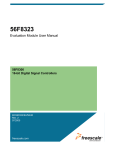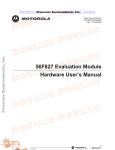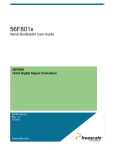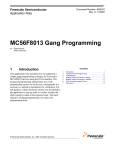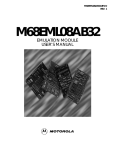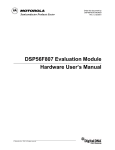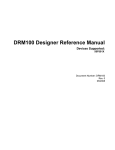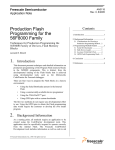Download 56F8014 - NXP Semiconductors
Transcript
56F8014 Demonstration Board User Guide 56F8000 16-bit Digital Signal Controllers MC56F8014DBUG Rev. 0 03/2005 freescale.com TABLE OF CONTENTS Preface vii Chapter 1 Introduction 1.1 1.2 56F8014 Demonstration Board Architecture . . . . . . . . . . . . . . . . . . . . . . . . . . . . . . . . . 1-1 56F8014 Demonstration Board Connections . . . . . . . . . . . . . . . . . . . . . . . . . . . . . . . . . 1-2 Chapter 2 Technical Summary 2.1 2.2 2.3 2.4 2.5 2.6 2.7 2.8 2.9 56F8014. . . . . . . . . . . . . . . . . . . . . . . . . . . . . . . . . . . . . . . . . . . . . . . . . . . . . . . . . . . . . . RS-232 Serial Communications . . . . . . . . . . . . . . . . . . . . . . . . . . . . . . . . . . . . . . . . . . . Debug LEDs . . . . . . . . . . . . . . . . . . . . . . . . . . . . . . . . . . . . . . . . . . . . . . . . . . . . . . . . . . Debug Support . . . . . . . . . . . . . . . . . . . . . . . . . . . . . . . . . . . . . . . . . . . . . . . . . . . . . . . . External Interrupts. . . . . . . . . . . . . . . . . . . . . . . . . . . . . . . . . . . . . . . . . . . . . . . . . . . . . . Reset . . . . . . . . . . . . . . . . . . . . . . . . . . . . . . . . . . . . . . . . . . . . . . . . . . . . . . . . . . . . . . . . Power Supply . . . . . . . . . . . . . . . . . . . . . . . . . . . . . . . . . . . . . . . . . . . . . . . . . . . . . . . . . Daughter Card Connector . . . . . . . . . . . . . . . . . . . . . . . . . . . . . . . . . . . . . . . . . . . . . . . . Test Points. . . . . . . . . . . . . . . . . . . . . . . . . . . . . . . . . . . . . . . . . . . . . . . . . . . . . . . . . . . . 2-2 2-2 2-3 2-4 2-5 2-5 2-6 2-7 2-8 Appendix A 56F8014 Demonstration Board Schematics Appendix B 56F8014 Demonstration Board Bill of Material Table of Contents, Rev. 0 Freescale Semiconductor Preliminary i 56F8014 Demonstration Board User Guide, Rev. 0 ii Freescale Semiconductor Preliminary LIST OF FIGURES 1-1 Block Diagram of the 56F8014 Demonstration Board . . . . . . . . . . . . . . . . . . . . . . . 1-2 1-2 Connecting the 56F8014 Demonstration Board Cables . . . . . . . . . . . . . . . . . . . . . . 1-3 2-1 Diagram of the Debug LED Interface . . . . . . . . . . . . . . . . . . . . . . . . . . . . . . . . . . . . 2-3 2-2 Block Diagram of the Parallel JTAG Interface . . . . . . . . . . . . . . . . . . . . . . . . . . . . . 2-4 2-3 Schematic Diagram of the User Interrupt Interface. . . . . . . . . . . . . . . . . . . . . . . . . . 2-5 List of Figures, Rev. 0 Freescale Semiconductor Preliminary iii 56F8014 Demonstration Board User Guide, Rev. 0 iv Freescale Semiconductor Preliminary LIST OF TABLES 2-1 RS-232 Serial Connector Description . . . . . . . . . . . . . . . . . . . . . . . . . . . . . . . . . 2-2 2-2 LED Control. . . . . . . . . . . . . . . . . . . . . . . . . . . . . . . . . . . . . . . . . . . . . . . . . . . . . 2-4 2-3 JTAG Connector Description. . . . . . . . . . . . . . . . . . . . . . . . . . . . . . . . . . . . . . . . 2-4 2-4 Daughter Card Connector Description. . . . . . . . . . . . . . . . . . . . . . . . . . . . . . . . . 2-7 List of Tables, Rev. 0 Freescale Semiconductor Preliminary v 56F8014 Demonstration Board User Guide, Rev. 0 vi Freescale Semiconductor Preliminary Preface This reference manual describes the hardware on the 56F8014 Demonstration Board in detail. Audience This document is intended for application developers who are creating software for devices using the Freescale 56F8014 Demonstration Board or a member of the 56F8000 family that is compatible with this part. Organization This manual is organized into two chapters and two appendices. • Chapter 1, Introduction, provides an overview of the Demo board and its features. • Chapter 2, Technical Summary, describes the 56F8014 hardware in detail. • Appendix A, 56F8014 Demonstration Board Schematics, , contains the schematics of the 56F8014 Demonstration Board. • Appendix B, 56F8014 Demonstration Board Bill of Material, provides a list of the materials used on the 56F8014 Demonstration Board. Suggested Reading More documentation on the 56F8014 and the 56F8014 Demonstration Board kit may be found at URL: www.freescale.com Preface, Rev. 0 Freescale Semiconductor Preliminary vii Notation Conventions This manual uses the following notational conventions: Term or Value Symbol Examples Active High Signals (Logic One) No special symbol attached to the signal name A0 CLKO Active Low Signals (Logic Zero) Noted with an overbar in text and in most figures WE OE Hexadecimal Values Begin with a “$” symbol Decimal Values No special symbol attached to the number Binary Values Begin with the letter “b” attached to the number b1010 b0011 Numbers Considered positive unless specifically noted as a negative value 5 -10 Blue Text Linkable on-line Bold Reference sources, paths, emphasis Exceptions In schematic drawings, Active Low Signals may be noted by a backslash: /WE $0FF0 $80 10 34 Voltage is often shown as positive: +3.3V ...refer to Chapter 7, License ...see: http://www.freescale.com/ 56F8014 Demonstration Board User Guide, Rev. 0 viii Freescale Semiconductor Preliminary Definitions, Acronyms, and Abbreviations Definitions, acronyms and abbreviations for terms used in this document are defined below for reference. 56F8014 Digital signal controller with motor control peripherals A/D Analog-to-Digital; a method of converting Analog signals to Digital values ADC Analog-to-Digital Converter; a peripheral on the 56F8014 part DSC Digital Signal Controller EOnCE Enhanced On-Chip Emulation; a debug bus and port which enables a designer to create a low-cost hardware interface for a professional-quality debug environment Demo Board Demonstration Board; a hardware platform which allows a customer to evaluate the silicon and develop his application GPIO General Purpose Input and Output port on Freescale’s family of digital signal controllers; does not share pin functionality with any other peripheral on the chip and can only be set as an input, output, or level-sensitive interrupt input IC Integrated Circuit JTAG Joint Test Action Group; a bus protocol/interface used for test and debug LED Light Emitting Diode LQFP OnCETM Low-profile Quad Flat Package On-Chip Emulation, a debug bus and port created to allow a means for low-cost hardware to provide a professional-quality debug environment PCB Printed Circuit Board PWM Pulse Width Modulation SCI Serial Communications Interface; a peripheral on Freescale’s family of digital signal controllers SPI Serial Peripheral Interface; a peripheral on Freescale’s family of digital signal controllers Preface, Rev. 0 Freescale Semiconductor Preliminary ix References The following sources were referenced to produce this manual: [1] DSP56800E Reference Manual, DSP56800ERM, Freescale Semiconductor, Inc. [2] 56F8000 Peripheral Reference Manual, MC56F8000RM, Freescale Semiconductor, Inc. [3] 56F8014 Technical Data, MC56F8014, Freescale Semiconductor, Inc. 56F8014 Demonstration Board User Guide, Rev. 0 x Freescale Semiconductor Preliminary Chapter 1 Introduction The 56F8014 Demonstration Board is used to demonstrate the abilities of the 56F8014 digital signal controller and to provide a hardware tool allowing the development of applications. The 56F8014 Demonstration Board is an evaluation module board that includes a 56F8014 part, RS-232 interface, user LEDs, user pushbutton switches and a daughter card connector. The daughter card connector allows signal monitoring and expandability of user features. The 56F8014 Demonstration Board is designed for the following purposes: • Allowing new users to become familiar with the features of the 56800E architecture. The tools and examples provided with the 56F8014 Demonstration Board facilitate evaluation of the feature set and the benefits of the family. • Serving as a platform for real-time software development. The tool suite enables the user to develop and simulate routines, download the software to on-chip memory, run it, and debug it using a debugger via the JTAG/Enhanced OnCE (EOnCE) port. The breakpoint features of the EOnCE port enable the user to easily specify complex break conditions and to execute user-developed software at full speed until the break conditions are satisfied. The ability to examine and modify all user-accessible registers, memory and peripherals through the EOnCE port greatly facilitates the task of the developer. • Serving as a platform for hardware development. The hardware platform enables the user to connect external hardware peripherals. The on-board peripherals can be disabled, providing the user with the ability to reassign any and all of the processor's peripherals. The EOnCE port's unobtrusive design means that all memory on the board and on the processor is available to the user. 1.1 56F8014 Demonstration Board Architecture The 56F8014 Demonstration Board facilitates the evaluation of various features present in the 56F8014 part. The 56F8014 Demonstration Board can be used to develop real-time software and Introduction, Rev. 0 Freescale Semiconductor Preliminary 1-1 hardware products. The 56F8014 Demonstration Board provides the features necessary for a user to write and debug software, demonstrate the functionality of that software and interface with the user's application-specific device(s). The 56F8014 Demonstration Board is flexible enough to allow a user to fully exploit the 56F8014's features to optimize the performance of his product, as shown in Figure 1-1. 56F8014 JTAG/EOnCE SCI JTAG Connector RS-232 Interface DSub 9-Pin SPI Timer A PWM Daughter Card Connector ADCA ADCB RESET Debug LEDs IRQ Pushbuttons RESET Pushbutton +3.3V & GND +3.3VA & AGND Power Supply +3.3V &+3.3VA Figure 1-1. Block Diagram of the 56F8014 Demonstration Board 1.2 56F8014 Demonstration Board Connections An interconnection diagram is shown in Figure 1-2 for connecting the PC and the external +9.0V DC power supply to the 56F8014 Demonstration Board. 56F8014 Demonstration Board User Guide, Rev. 0 1-2 Freescale Semiconductor Preliminary 56F8014 Demonstration Board Connections Parallel Extension Cable PC-compatible Computer 56F8014 Demonstration Board JTAG POD J1 Connect cable to Parallel/Printer port P1 External with 2.1mm, +9V receptacle Power connector Figure 1-2. Connecting the 56F8014 Demonstration Board Cables Perform the following steps to connect the 56F8014 Demonstration Board cables: 1. Connect the parallel extension cable to the parallel port of the host computer. 2. Connect the other end of the parallel extension cable to the JTAG interface POD. Connect the ribbon cable from the JTAG interface POD to J1, shown in Figure 1-2, on the 56F8014 Demonstration Board. This provides the connection which allows the host computer to control the board. 3. Make sure that the external +9V DC, 450mA power supply is not plugged into a +120V AC power source. 4. Connect the 2.1mm output power plug from the external power supply into P1, shown in Figure 1-2, on the 56F8014 Demonstration Board. 5. Apply power to the external power supply. The green Power-ON LED, LED7, will illuminate when power is correctly applied. Introduction, Rev. 0 Freescale Semiconductor Preliminary 1-3 56F8014 Demonstration Board User Guide, Rev. 0 1-4 Freescale Semiconductor Preliminary Chapter 2 Technical Summary The 56F8014 Demonstration Board is designed as a versatile development card using the 56F8014 processor, allowing the creation of real-time software and hardware products to support a new generation of applications in servo and motor control, digital and wireless messaging, digital answering machines, feature phones, modems, and digital cameras. The power of the 16-bit 56F8014 processor, combined with the on-board RS-232 interface and daughter card connector, makes the 56F8014 Demonstration Board ideal for developing and implementing many motor control algorithms, as well as for learning the architecture and instruction set of the 56F8014 processor. The main features of the 56F8014 Demonstration Board, with board and schematic reference, designators include: • 56F8014, a 16-bit +3.3V hybrid controller operating at 60MHz [U1] • Joint Test Action Group (JTAG) port interface connector, for an external debug Host Target Interface [J1] • RS-232 interface, for easy connection to a host processor [U2 and P3] • Daughter card connector, to allow the user to connect his own PWM, ADC, SCI, SPI or GPIO-compatible peripheral to the digital signal controller [P2] • On-board power regulation provided from an external +9V DC-supplied power input [P1] • Light Emitting Diode (LED) power indicator [LED7] • Six on-board real-time user debugging LEDs [LED1-6] • Manual RESET push-button [S3] • Manual interrupt #1 push-button [S1] • Manual interrupt #2 push-button [S2] Technical Summary, Rev. 0 Freescale Semiconductor Preliminary 2-1 2.1 56F8014 The 56F8014 Demonstration Board uses a Freescale 56F8014 part, designated as U1 on the board and in the schematics. This part will operate at a maximum external bus speed of 60MHz. A full description of the 56F8014, including functionality and user information, is provided in these documents: • 56F8014 Technical Data Sheet, (56F8014): Electrical and timing specifications, pin descriptions, device-specific peripheral information and package descriptions • 56F8000 Peripheral Reference Manual, (MC56F8000RM): Detailed description of peripherals of the 56F8000 family of devices • DSP56800E Reference Manual, (DSP56800ERM): Detailed description of the 56800E family architecture, 16-bit core processor, and the instruction set Refer to these documents for detailed information about chip functionality and operation. They can be found on this URL: www.freescale.com 2.2 RS-232 Serial Communications The 56F8014 Demonstration Board provides an RS-232 interface by the use of an RS-232 level converter, Sipex SP3220EUCY, designated as U2. Refer to the RS-232 schematic details in Appendix A. The RS-232 level converter transitions the SCI port’s +3.3V signal levels to RS-232 compatible signal levels and connects to the host’s serial port via connector P3. The SCI ports signals, GPIOB6 and GPIOB7, can be disconnected from the RS-232 level converter by cutting the JP1 and JP2 jumpers on the board. The pin-out of connector P2 is shown in Table 2-1. . Table 2-1. RS-232 Serial Connector Description P3 Pin # Signal Pin # Signal 1 Jumper to 6 & 4 6 Jumper to 1 & 4 2 TXD 7 NC 3 RXD 8 NC 4 Jumper to 1 & 6 9 NC 5 GND 56F8014 Demonstration Board User Guide, Rev. 0 2-2 Freescale Semiconductor Preliminary Debug LEDs 2.3 Debug LEDs Six on-board Light-Emitting Diodes, (LEDs), are provided to allow real-time debugging for user programs. These LEDs will allow the programmer to monitor program execution without having to stop the program during debugging; refer to Figure 2-1. Table 2-2 describes the control of each LED. Setting GPIOA0, GPIOA1, GPIOA2, GPIOA4, GPIOA5, or GPIOB4 to a Logic One value will turn on the associated LED. 56F8014 INVERTING BUFFER +3.3V RED LED GPIOA0 YELLOW LED GPIOA1 GREEN LED GPIOA2 RED LED GPIOA4 YELLOW LED GPIOA5 GREEN LED GPIOB4 Figure 2-1. Diagram of the Debug LED Interface Technical Summary, Rev. 0 Freescale Semiconductor Preliminary 2-3 Table 2-2. LED Control Controlled by User LED Color Signal LED1 RED GPIO Port A, Bit 0 LED2 YELLOW GPIO Port A, Bit 1 LED3 GREEN GPIO Port A, Bit 2 LED4 RED GPIO Port A, Bit 4 LED5 YELLOW GPIO Port A, Bit 5 LED6 GREEN GPIO Port B, Bit 4 2.4 Debug Support A JTAG connector, J1, on the 56F8014 Demonstration Board allows the connection of an external Host Target Interface for downloading programs and working with the 56F8014’s registers. This connector is used to communicate with an external Host Target Interface, which passes information and data back and forth with a host processor running a debugger program. Table 2-3 shows the pin-out for this connector. Table 2-3. JTAG Connector Description J1 Pin # Signal Pin # Signal 1 TDI 2 GND 3 TDO 4 GND 5 TCK 6 GND 7 NC 8 KEY 9 RESET 10 TMS 11 +3.3V 12 NC 13 DE 14 NC 56F8014 Demonstration Board User Guide, Rev. 0 2-4 Freescale Semiconductor Preliminary Reset 2.5 External Interrupts Two on-board push-button switches are provided for external interrupt generation, as shown in Figure 2-3. S1 allows the user to generate a hardware interrupt, IRQ #1, using GPIO Port B, Bit 2. S2 allows the user to generate a hardware interrupt, IRQ #2, using GPIO Port B, Bit 3. These two switches allow the user to generate interrupts for his user-specific programs. Alternately, the user can use GPIO Port B, Bit 4 for IRQ #1. To accomplish this, cut the trace at JP3 pins 1 & 2 and solder a jumper between JP3 pins 2 & 3. Also, the user can use GPIO Port B, Bit 5 for IRQ #2. To accomplish this, cut the trace at JP4 pins 1 & 2 and solder a jumper between JP4 pins 2 & 3. +3.3V 56F8014 10K S1 JP3 GPIOB2 1 2 GPIOB4 3 0.1µF +3.3V 10K S2 JP4 1 GPIOB3 2 0.1µF 3 GPIOB5 Figure 2-2. Schematic Diagram of the User Interrupt Interface 2.6 Reset Logic is provided on the 56F8014 to generate an internal Power-On RESET. Additional reset logic is provided to support the RESET signal from the JTAG connector and the user RESET push-button, S3; refer to the schematics in Appendix A. Technical Summary, Rev. 0 Freescale Semiconductor Preliminary 2-5 2.7 Power Supply The main power input to the 56F8014 Demonstration Board, +9V DC at 450mA, is through a 2.1mm coax power jack, P1. This input power passes through a reverse power-blocking diode to provide a DC supply input for the +3.3V voltage regulator, U3. A 450mA power supply is provided with the 56F8014 Demonstration Board; however, less than 200mA is required by the Demo Board. The remaining current is available for custom control applications when connected to the daughter card connector. The 56F8014 Demonstration Board provides +3.3V DC voltage regulation for the processor, ADC, JTAG interface and supporting logic; refer to schematics in Appendix A. Additional voltage regulation logic provides a low-noise +3.3V DC voltage to the processor’s A/D peripheral. Power applied to the 56F8014 Demonstration Board is indicated with a Power-ON LED, referenced as LED7. 56F8014 Demonstration Board User Guide, Rev. 0 2-6 Freescale Semiconductor Preliminary Daughter Card Connector 2.8 Daughter Card Connector The Demo board contains a daughter card connector, P2, which contains the processor’s peripheral port signals. The daughter card connector is used to connect a daughter card or a user-specific daughter card to the processor’s peripheral port signals. The daughter card connector is a 40-pin 0.1” pitch connector with signals for RESET, SPI, SCI, PWM, ADC and GPIO ports. Table 2-4 shows the daughter card connector’s signal-to-pin assignments. Table 2-4. Daughter Card Connector Description P2 Pin # Signal Pin # Signal 1 +3.3V 2 NC 3 GND 4 GPIOA7 / RESET / VPP 5 GPIOB7 / TXD / SCL 6 NC 7 GPIOB6 / RXD / SDA / CLKIN 8 NC 9 GPIOA0 / PWM0 10 GPIOC0 / ANA0 11 GPIOA1 / PWM1 12 GPIOC1 / ANA1 13 GPIOB4 / T0 / CLK0 14 GPIOC2 / VREFH / ANA2 15 GPIOB5 / T1 / FAULT3 16 GPIOC3 / ANA3 17 GPIOB3 / MOSI / T3 18 GPIOC4 / ANB0 19 GPIOB2 / MISO / T2 20 GPIOC5 / ANB1 21 GPIOB0 / SCLK / SCL 22 GPIOC6 / VREFL / ANB2 23 GPIOB1 / SS / SDA 24 GPIOC7 / ANB3 25 GPIOD0 / TDI 26 GPIOB1 / SS / SDA 27 GPIOD1 / TDO 28 GPIOB0 / SCLK / SCL 29 GPIOD2 / TCK 30 GPIOA2 / PWM2 31 GPIOD3 / TMS 32 NC 33 NC 34 GPIOA4 / PWM4 / FAULT1 / T2 35 NC 36 GPIOA5 / PWM5 / FAULT2 / T3 37 NC 38 NC 39 NC 40 NC Technical Summary, Rev. 0 Freescale Semiconductor Preliminary 2-7 2.9 Test Points The 56F8014 Demonstration Board board has two test points: • +3.3V, TP1 • Digital Ground (GND), TP2 56F8014 Demonstration Board User Guide, Rev. 0 2-8 Freescale Semiconductor Preliminary Appendix A 56F8014 Demonstration Board Schematics 56F8014 Demonstration Board Schematics, Rev. 0 Freescale Semiconductor Preliminary Appendix A -1 56F8014 Demonstration Board User Guide, Rev. 0 Appendix A -2 Freescale Semiconductor Preliminary 1 2 3 4 PB0 PB1 PB2 PB3 PB4 PB5 PB6 PB7 PA4 PA5 PA0 PA1 PA2 +3.3V A 2 1 4 3 6 5 7 KEY 10 9 11 12 13 14 GNDA B /TRST TMS GND GND GND C15 0.001uF L1 L2 C5 0.1uF B R1 100 R6 C21 0.0022uF ANB_3 D /DE TDO E 47K R21 47K R20 DNP +3.3V ANB3 ANB2 ANB1 ANB0 (512) 895-7215 Sheet 1 E of 5 FAX: (480) 413-2510 2100 East Elliot Road Tempe, Arizona 85284 1.0 Rev. Digital Signal Controller Operation 10K R23 DNP Designer: DSCO Design TMS 10K R22 C24 0.0022uF C20 0.0022uF R8 100 ANA3 100 R4 C23 0.0022uF R7 C19 0.0022uF ANA2 100 R3 100 MC56F8014DEMO.DSN C TCK +3.3V R5 100 C22 0.0022uF ANB_2 ANB_1 ANB_0 C18 0.0022uF ANA1 ANA0 100 D 100 R2 C17 0.0022uF Date: Wednesday, December 08, 2004 Document Number ANA_3 ANA_2 ANA_1 ANA_0 Figure A-1. MC56F8014 Processor A Size C14 0.01uF C MC56F8014 Processor GND C1 2.2uF +3.3V +3.3VA ANB_0 ANB_1 ANB_2 ANB_3 ANA_0 ANA_1 ANA_2 ANA_3 +3.3V 14 26 24 25 8 9 4 5 6 7 13 12 11 10 Title FERRITE BEAD C4 0.1uF FERRITE BEAD MC56F8014VFAE ANA0/PC0 ANA1/PC1 ANA2/VREFH/PC2 ANA3/PC3 PA4/PWM4/FAULT1/T2 PA5/PWM5/FAULT2/T3 ANB0/PC4 ANB1/PC5 ANB2/VREFL/PC6 PB0/SCLK/SCL ANB3/PC7 PB1/SS/SDA VDDA_ADC PB2/MISO/T2 PB3/MOSI/T3 VSSA_ADC PB4/T0/CLKO PB5/T1/FAULT3 PB6/RXD/SDA/CLKIN VDD_IO PB7/TXD/SCL VCAP1 TDI/PD0 TDO/PD1 TCK/PD2 TMS/PD3 VSS_IO0 VSS_IO1 RESET/PA7/VPP U1 PA0/PWM0 PA1/PWM1 PA2/PWM2 JTAG Connector /DE /RESET TDI TDO TCK J1 16 29 31 15 30 21 1 18 17 19 3 32 2 22 20 28 27 23 C16 100pF +3.3VA Single trace to GNDA /RESET TDI TDO TCK TMS A 1 2 3 4 56F8014 Demonstration Board Schematics, Rev. 0 Freescale Semiconductor Preliminary Appendix A -3 1 2 3 4 A RESET PUSHBUTTON S3 S2 IRQ PUSHBUTTON #2 S1 IRQ PUSHBUTTON #1 A R19 10K +3.3V +3.3V B C13 0.1uF Bypass /RESET JP4 JP3 A Size Title PB5 PB3 PB4 PB2 3 11 5 9 T0/CLKO 1 PWM5/T3 13 PWM4/T2 PWM2 PWM1 PWM0 74AC04 U4A 74AC04 U4F 74AC04 U4B 74AC04 U4E 74AC04 U4C 74AC04 U4D 2 12 4 10 6 8 D C LED6 LED5 LED4 LED3 LED2 D +3.3V GREEN LED YELLOW LED RED LED GREEN LED YELLOW LED RED LED E (512) 895-7215 Sheet 2 E of 5 FAX: (480) 413-2510 2100 East Elliot Road Tempe, Arizona 85284 1.0 Rev. Digital Signal Controller Operation 270 R14 270 R13 270 R12 270 R11 270 R10 270 R9 LED1 Designer: DSCO Design MC56F8014DEMO.DSN Date: Sunday, September 26, 2004 Document Number RESET & IRQ PUSHBUTTONS AND USER LEDS PB4 PA5 PA4 PA2 PA1 PA0 C Figure A-2. RESET & IRQ Pushbuttons and User LEDs C7 0.1uF R18 10K +3.3V C6 0.1uF R17 10K +3.3V B 1 2 3 4 56F8014 Demonstration Board User Guide, Rev. 0 Appendix A -4 Freescale Semiconductor Preliminary 1 2 3 4 A A PB6 PB7 JP2 JP1 B B RXD TXD A Size Title +3.3V C12 0.1uF Bypass EN RIN TOUT GND V+ V- VCC SP3220EUCY FORCEON SHDN ROUT TIN C2- C1C2+ C1+ 1K R16 RD TD C11 0.1uF 0.1uF C10 +3.3V C D D 1 6 2 7 3 8 4 9 5 P3 DCD DSR TXD CTS RXD RTS DTR E (512) 895-7215 Sheet 3 E of 5 FAX: (480) 413-2510 2100 East Elliot Road Tempe, Arizona 85284 1.0 Rev. Digital Signal Controller Operation RS-232 CONNECTOR Designer: DSCO Design MC56F8014DEMO.DSN 1 8 13 14 3 7 15 Date: Sunday, September 26, 2004 Document Number RS-232 INTERFACE 12 16 9 11 6 4 5 U2 Figure A-3. RS-232 Interface +3.3V C9 0.1uF C8 0.1uF 2 C 1 2 3 4 56F8014 Demonstration Board Schematics, Rev. 0 Freescale Semiconductor Preliminary Appendix A -5 1 2 3 4 A A GND A Size Title PB7 PB6 PA0 PA1 PB4 PB5 PB3 PB2 PB0 PB1 TDI TDO TCK TMS GND 1 3 5 7 9 11 13 15 17 19 21 23 25 27 29 31 33 35 37 39 P2 2 4 6 8 10 12 14 16 18 20 22 24 26 28 30 32 34 36 38 40 PWM4/FAULT1/T2 PWM5/FAULT2/T3 PC0 PC1 VREFH/PC2 PC3 PC4 PC5 VREFL/PC6 PC7 SS_b/SDA SCLK/SCL PWM2 PA7/VPP C PA4 PA5 ANA0 ANA1 ANA2 ANA3 ANB0 ANB1 ANB2 ANB3 PB1 PB0 PA2 /RESET D D E (512) 895-7215 Sheet 4 E of 5 FAX: (480) 413-2510 2100 East Elliot Road Tempe, Arizona 85284 1.0 Rev. Digital Signal Controller Operation Designer: DSCO Design MC56F8014DEMO.DSN Date: Thursday, February 10, 2005 Document Number INPUT/OUTPUT SIGNAL CONNECTOR LOCATED ON BOTTOM OF BOARD I/O SIGNAL SOCKET TXD/SCL RXD/SDA/CLKIN PWM0 PWM1 T0/CLKO T1/FAULT3 MOSI/T3 MISO/T2 SCLK/SCL SS_b/SDA PD0 PD1 PD2 PD3 +3.3V C Figure A-4. Input / Output Signal Connector B B 1 2 3 4 56F8014 Demonstration Board User Guide, Rev. 0 1 2 3 A P1 1 4 2 3 LM1117 1 3.3V REGULATOR 2 FM4001 D1 EXTERNAL POWER 9VDC INPUT 3 4 + +9V B C2 22uF 16VDC B VOUT VOUT 4 2 +3.3V TP2 GROUND TEST POINT C3 22uF 6.3VDC C D D E (512) 895-7215 Sheet 5 E of 5 FAX: (480) 413-2510 2100 East Elliot Road Tempe, Arizona 85284 1.0 Rev. Digital Signal Controller Operation POWER GOOD LED LED7 GREEN LED R15 270 +3.3V Designer: DSCO Design MC56F8014DEMO.DSN + Date: Sunday, September 26, 2004 Document Number POWER SUPPLY +3.3V TP1 +3.3V TEST POINT LM1117MPX-3.3 GND VIN U3 C Figure A-5. Power Supply A Size Title 1 3 1 A 1 Appendix A -6 Freescale Semiconductor Preliminary 1 2 3 4 Appendix B 56F8014 Demonstration Board Bill of Material Qty Description Ref. Designators Vendor Part # Integrated Circuits 1 MC56F8014 U1 Freescale, MC56F8014VFAE 1 RS-232 Transceiver U2 Sipex, SP3220EUCY 1 +3.3V Voltage Regulator U3 National Semi, LM1117MPX-3.3 1 74AC04 U4 ON Semiconductor, MC74AC04AD Resistors 8 100 Ω, 0603 R1 — R8 SMEC, RC73L2X101JT 7 270 Ω, 0603 R9 — R15 SMEC, RC73L2X271JT 1 1K Ω, 0603 R16 SMEC, RC73L2X102JT 4 10K Ω, 0603 R17 — R19, R23 SMEC, RC73L2X103JT 0 47K Ω, 0603 R20 (Optional) SMEC, RC73L2X473JT 1 47K Ω, 0603 R21 SMEC, RC73L2X473JT 0 10K Ω, 0603 R22 (Optional) SMEC, RC73L2X103JT Inductors 2 Ferrite Bead, 0604 L1 — L2 SMEC, FCB0603-1000HNT LEDs 2 Red LED, 1206 LED1, LED4 Hewlett-Packard, HSMS-C650 2 Yellow LED, 1206 LED2, LED5 Hewlett-Packard, HSMY-C650 2 Green LED, 1206 LED3, LED6, LED7 Hewlett-Packard, HSMG-C650 56F8014 Demonstration Board Bill of Material, Rev. 0 Freescale Semiconductor Preliminary Appendix B -1 Qty Description Ref. Designators Vendor Part # Diode 1 S2B-FM401, SMA D1 Vishay, DL4001DICT Capacitors 1 2.2µF, +25V DC, 0805 (Low ESR) C1 TAIYO YUDEN, CELMK212BJ225MG-T 1 22µF, +16V DC, EIA-B C2 SMEC, TCC22K16B 1 22µF, +6.3V DC, EIA-A C3 SMEC, TCC22M6.3A 10 0.1µF, 0603 C4 — C13 SMEC, MCCA104K1NR-T1 1 0.01µF, 0603 C14 SMEC, MCCA103K1NR-T1 1 0.001µF, 0603 C15 SMEC, MCCA102K1NRT 1 100pF, 0603 C16 SMEC, MCCA101K1NRT 6 0.0022µF, 0603 C17 — C24 SMEC, MCCA222K1NRT Test Points 0 +3.3V Test Point TP1 (Optional) KEYSTONE, 5000, RED 0 GND Test Point TP2 (Optional) KEYSTONE, 5001, BLACK Connectors 1 2.1mm coax Power Connector P1 Switchcraft, RAPC-722 1 Daughter Card Connector P2 SAMTEC, SSM-120-L-DV-LC 1 DE9S Connector P3 AMPHENOL, 617-C009S-AJ120 1 7x2 JTAG Header J1 SAMTEC, TSW-107-07-S-D Switches 3 SPST Pushbutton S1 — S3 Panasonic, EVQ-PAD05R Miscellaneous 2 Stand-off Post, 4-40 Aluminum 0.25” Hex Female, 0.375” 2 4-40 Screws SAE 4-40 machine screw, 0.375” 56F8014 Demonstration Board User Guide, Rev. 0 Appendix B -2 Freescale Semiconductor Preliminary INDEX Numerics J 1.2 Amp power supply 2-6 56F8014 ix 56F8300 Peripheral User Manual 2-2 56F8357 Technical Data Sheet 2-2 Joint Test Action Group JTAG ix JTAG ix JTAG/Enhanced OnCE (EOnCE) 1-1 A L A/D ix ADC ix Analog-to-Digital A/D ix Analog-to-Digital Converter ADC ix LED ix Light Emitting Diode LED ix Low-profile Quad Flat Package LQFP ix LQFP ix D O Daughter Card Expansion interface 2-1 Debugging 2-3 Demo Board Demonstration Board ix Digital Signal Controller DSC ix DSC ix DSP56800E Reference Manual 2-2 On-board power regulation 2-1 OnCE ix On-Chip Emulation OnCE ix E Enhanced On-Chip Emulation EOnCE ix EOnce ix G P PCB ix peripheral port signals 2-7 Printed Circuit Board PCB ix Pulse Width Modulation PWM ix PWM ix R General Purpose Input and Output GPIO ix GPIO ix real-time debugging 2-3 RS-232 level converter 2-2 schematic diagram 2-2 I S IC ix Integrated Circuit IC ix SCI ix Serial Communications Interface SCI ix Serial Peripheral Interface SPI ix SPI ix Index, Rev. 0 Freescale Semiconductor Preliminary i How to Reach Us: Home Page: www.freescale.com E-mail: [email protected] USA/Europe or Locations Not Listed: Freescale Semiconductor Technical Information Center, CH370 1300 N. Alma School Road Chandler, Arizona 85224 +1-800-521-6274 or +1-480-768-2130 [email protected] Europe, Middle East, and Africa: Freescale Halbleiter Deutschland GmbH Technical Information Center Schatzbogen 7 81829 Muenchen, Germany +44 1296 380 456 (English) +46 8 52200080 (English) +49 89 92103 559 (German) +33 1 69 35 48 48 (French) [email protected] Japan: Freescale Semiconductor Japan Ltd. Headquarters ARCO Tower 15F 1-8-1, Shimo-Meguro, Meguro-ku, Tokyo 153-0064, Japan 0120 191014 or +81 3 5437 9125 [email protected] Asia/Pacific: Freescale Semiconductor Hong Kong Ltd. Technical Information Center 2 Dai King Street Tai Po Industrial Estate Tai Po, N.T., Hong Kong +800 2666 8080 [email protected] For Literature Requests Only: Freescale Semiconductor Literature Distribution Center P.O. Box 5405 Denver, Colorado 80217 1-800-441-2447 or 303-675-2140 Fax: 303-675-2150 [email protected] Information in this document is provided solely to enable system and software implementers to use Freescale Semiconductor products. There are no express or implied copyright licenses granted hereunder to design or fabricate any integrated circuits or integrated circuits based on the information in this document. Freescale Semiconductor reserves the right to make changes without further notice to any products herein. Freescale Semiconductor makes no warranty, representation or guarantee regarding the suitability of its products for any particular purpose, nor does Freescale Semiconductor assume any liability arising out of the application or use of any product or circuit, and specifically disclaims any and all liability, including without limitation consequential or incidental damages. “Typical” parameters that may be provided in Freescale Semiconductor data sheets and/or specifications can and do vary in different applications and actual performance may vary over time. All operating parameters, including “Typicals”, must be validated for each customer application by customer’s technical experts. Freescale Semiconductor does not convey any license under its patent rights nor the rights of others. Freescale Semiconductor products are not designed, intended, or authorized for use as components in systems intended for surgical implant into the body, or other applications intended to support or sustain life, or for any other application in which the failure of the Freescale Semiconductor product could create a situation where personal injury or death may occur. Should Buyer purchase or use Freescale Semiconductor products for any such unintended or unauthorized application, Buyer shall indemnify and hold Freescale Semiconductor and its officers, employees, subsidiaries, affiliates, and distributors harmless against all claims, costs, damages, and expenses, and reasonable attorney fees arising out of, directly or indirectly, any claim of personal injury or death associated with such unintended or unauthorized use, even if such claim alleges that Freescale Semiconductor was negligent regarding the design or manufacture of the part. Freescale™ and the Freescale logo are trademarks of Freescale Semiconductor, Inc. All other product or service names are the property of their respective owners. This product incorporates SuperFlash® technology licensed from SST. © Freescale Semiconductor, Inc. 2004. All rights reserved. MC56F8014DBUG Rev. 0 03/2005




































